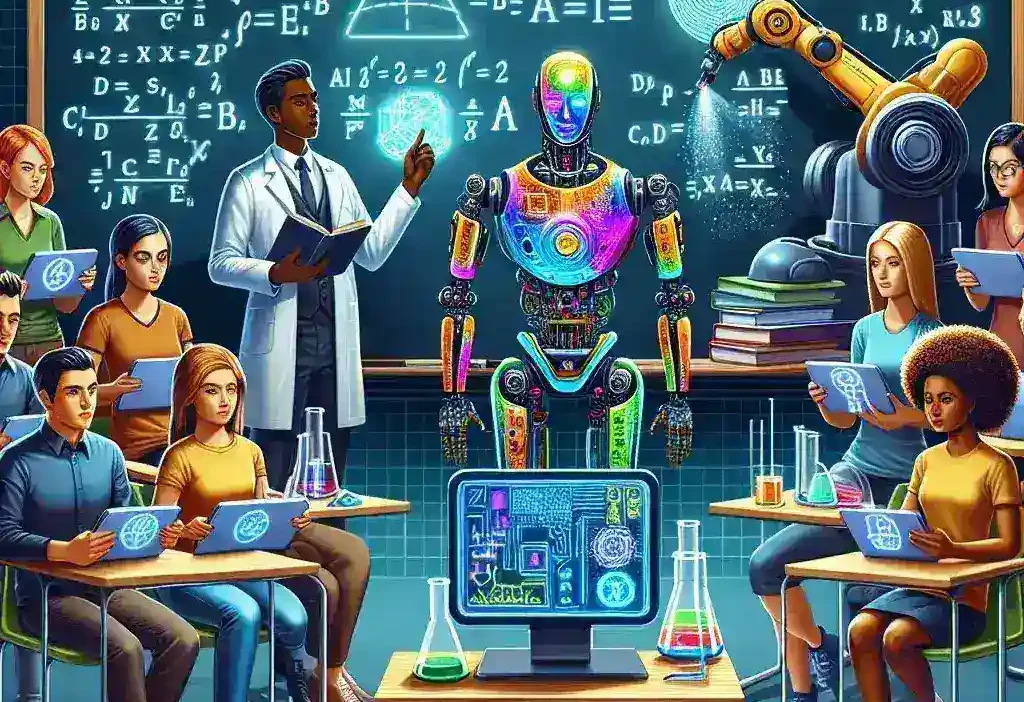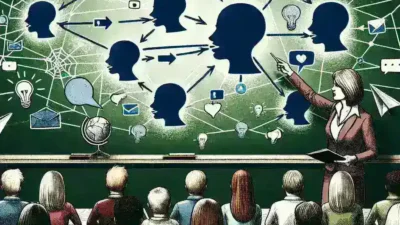Understanding the Evolution of AI in Educational Settings
The integration of artificial intelligence into educational frameworks represents one of the most significant paradigm shifts in modern pedagogy. As classroom dynamics continue to evolve in response to technological advancements, AI has emerged as a powerful tool for educators seeking to identify and address learning gaps among diverse student populations. The traditional “one-size-fits-all” approach to education has long been recognized as inadequate for meeting the unique needs of individual learners, but until recently, the practical limitations of personalized instruction seemed insurmountable. Artificial intelligence has fundamentally altered this equation.
Historically, the identification of learning gaps relied heavily on standardized assessments and teacher observations—methods that, while valuable, often failed to capture the nuanced nature of cognitive development and learning progression. The introduction of AI-driven educational tools has transformed this landscape, offering unprecedented insights into student performance and learning patterns. These technologies not only identify gaps with remarkable precision but also adapt instructional approaches to address these specific deficiencies.
The Historical Context of Learning Gap Assessment
Before delving into the revolutionary impact of AI on learning gap identification, it’s worth examining the historical context of educational assessment. Throughout most of the 20th century, educators relied primarily on summative assessments—end-of-unit tests, standardized examinations, and periodic evaluations—to gauge student understanding and identify areas requiring additional attention. While these methods provided valuable snapshots of academic performance, they suffered from significant limitations:
- They often identified learning gaps only after substantial instructional time had elapsed
- They frequently failed to pinpoint the specific nature of conceptual misunderstandings
- They rarely offered actionable insights for personalized remediation
- They didn’t account for different learning styles and cognitive processes
- They created high-pressure situations that sometimes obscured true understanding
As educational psychology advanced throughout the latter half of the 20th century, formative assessment gained prominence as a complementary approach. These ongoing evaluations aimed to provide continuous feedback throughout the learning process, enabling more timely interventions. However, the practical implementation of comprehensive formative assessment remained challenging due to resource constraints and the cognitive demands placed on educators managing diverse classrooms.
How AI Transforms Learning Gap Identification
The advent of sophisticated AI applications in education has revolutionized the process of identifying learning gaps through several distinct mechanisms. These technologies leverage complex algorithms, machine learning capabilities, and vast data processing capacities to detect patterns and anomalies in student performance that might otherwise remain invisible to human observers.
Real-Time Performance Analysis
One of the most powerful capabilities of AI-enabled educational platforms is their ability to conduct real-time analysis of student performance. Unlike traditional assessment methods that provide periodic snapshots of understanding, AI systems continuously monitor student interactions with learning materials, documenting every response, hesitation, and engagement pattern. This perpetual stream of data allows for the immediate identification of conceptual misunderstandings or skill deficiencies as they emerge.
For example, adaptive learning platforms can track how students navigate through problem-solving exercises, noting when they struggle with specific concepts or repeatedly make similar errors. These systems can identify precisely when a student’s understanding begins to falter, often before the student themselves recognizes the difficulty.
Pattern Recognition Across Learning Domains
AI systems excel at recognizing patterns across diverse learning domains and activities. While a human educator might struggle to connect a student’s difficulty in one subject area with challenges in another, AI can identify correlations that suggest underlying cognitive patterns or learning style preferences.
Consider a student who struggles with certain types of word problems in mathematics but also demonstrates similar difficulties with causal reasoning in science explanations. An AI system might recognize this pattern and identify a fundamental gap in conditional logical reasoning that spans multiple subject areas—an insight that could easily escape notice in traditional subject-siloed assessment approaches.
Predictive Analytics for Proactive Intervention
Perhaps the most revolutionary aspect of AI in learning gap identification is the capacity for predictive analytics. By analyzing current performance patterns against vast databases of historical student data, AI systems can predict future learning challenges with remarkable accuracy. This predictive capability enables truly proactive educational interventions, addressing potential learning gaps before they fully materialize.
Advanced educational AI platforms can alert educators when a student’s current performance trajectory suggests they may struggle with upcoming concepts or skills. This foresight allows for preemptive scaffolding and support that can prevent the formation of significant learning gaps altogether—a dramatic improvement over the reactive approach necessitated by traditional assessment methods.
Specific AI Technologies Addressing Learning Gaps
The field of educational AI encompasses a diverse array of technologies and approaches, each offering unique capabilities for identifying and addressing learning gaps. Understanding these specific applications provides insight into how AI is transforming educational practice at multiple levels.
Intelligent Tutoring Systems (ITS)
Intelligent Tutoring Systems represent one of the most mature applications of AI in education. These comprehensive platforms simulate one-on-one tutoring by providing personalized instruction, feedback, and assessment tailored to individual student needs. Modern ITS platforms employ sophisticated cognitive models that track student knowledge states and learning progressions with remarkable precision.
The power of ITS in addressing learning gaps lies in their ability to:
- Dynamically adjust instructional pacing based on student mastery
- Provide targeted explanations that address specific misconceptions
- Offer varied presentation methods to accommodate different learning preferences
- Generate practice problems that target identified areas of weakness
- Maintain detailed records of student progress across learning objectives
Research has consistently demonstrated the effectiveness of well-designed ITS platforms in reducing learning gaps, with some studies showing learning gains comparable to those achieved with human tutors—particularly impressive considering these systems can scale to serve thousands of students simultaneously.
Natural Language Processing for Conceptual Understanding
Advances in natural language processing (NLP) have created powerful new avenues for assessing student understanding and identifying conceptual gaps. NLP-enabled educational tools can analyze student-written responses, discussions, and explanations to evaluate conceptual understanding at a depth previously impossible with multiple-choice or simple constructed-response assessments.
These technologies can identify subtle indicators of partial understanding or misconceptions in student language, distinguishing between superficial familiarity with terminology and genuine conceptual mastery. For example, an NLP system might recognize when a student uses scientific vocabulary correctly but structures explanations in ways that reveal fundamental misconceptions about causal relationships or underlying principles.
By analyzing linguistic patterns across multiple responses over time, these systems can construct detailed maps of student conceptual development, precisely identifying gaps in understanding that require targeted intervention. This capability proves particularly valuable in subject areas where conceptual understanding, rather than procedural knowledge, forms the foundation for advanced learning.
Learning Analytics Dashboards
Learning analytics dashboards aggregate and visualize educational data to provide educators with comprehensive overviews of student performance and engagement. These powerful tools transform raw data into actionable insights, enabling teachers to identify learning gaps across individuals, groups, and entire classrooms.
Modern learning analytics platforms incorporate sophisticated AI capabilities that go beyond simple performance metrics to identify complex patterns and provide nuanced recommendations. These systems might, for instance, recognize when a particular instructional approach proves consistently ineffective for students with specific learning profiles, suggesting alternative strategies better suited to these learners’ needs.
The most advanced learning analytics dashboards employ clustering algorithms to identify groups of students with similar learning patterns, helping educators recognize systemic learning gaps that might require curricular adjustments rather than individual interventions. This capacity for multi-level analysis makes these tools invaluable for both classroom teachers and educational administrators seeking to address learning gaps at institutional scales.
Personalized Learning Paths: AI-Driven Solutions to Learning Gaps
The identification of learning gaps, while crucial, represents only half of the educational equation. The true power of AI in education lies in its ability to not only identify these gaps but also to develop and implement personalized learning paths that address individual student needs with unprecedented precision.
Adaptive Learning Algorithms
At the heart of AI-driven personalized learning lies adaptive learning algorithms—sophisticated systems that continuously adjust instructional content, pacing, and approach based on individual student performance. Unlike traditional educational software that follows predetermined sequences, adaptive platforms dynamically reconfigure learning paths in response to student interactions.
These systems typically operate through a process of:
- Assessment: Evaluating student responses to determine current knowledge state
- Analysis: Comparing performance against learning objectives to identify gaps
- Selection: Choosing optimal instructional content to address identified gaps
- Delivery: Presenting content through appropriate modalities and scaffolding
- Reassessment: Continuously evaluating understanding to refine future selections
This iterative process creates highly individualized learning experiences that efficiently target specific learning gaps. Research indicates that well-designed adaptive learning systems can significantly reduce the time required for students to achieve mastery of concepts, with particularly pronounced benefits for struggling learners.
Multimodal Learning Approaches
A significant advantage of AI-driven educational platforms is their ability to present information through multiple modalities, accommodating diverse learning preferences and addressing gaps that may be specific to particular presentation formats. These systems recognize when students struggle with content presented in one format and automatically offer alternative approaches.
For instance, if a student demonstrates difficulty grasping a mathematical concept presented symbolically, an AI system might automatically pivot to visual representations, interactive simulations, or contextual applications. This multimodal flexibility proves especially valuable for addressing learning gaps stemming from mismatches between instructional presentation and individual cognitive preferences.
Advanced systems can even identify patterns in modality effectiveness across different concept types, developing sophisticated profiles of when particular students benefit most from specific presentation approaches. This level of personalization far exceeds what human educators could practically implement in traditional classroom settings.
Gamification and Motivational Design
Learning gaps often stem not only from cognitive challenges but also from motivational and engagement issues. AI educational platforms increasingly incorporate sophisticated gamification elements and motivational design principles that adapt to individual student preferences and engagement patterns.
These systems might recognize when a particular student responds positively to competitive elements, collaborative opportunities, narrative frameworks, or achievement recognition, adjusting the presentation of learning activities accordingly. By personalizing motivational approaches alongside cognitive content, these platforms address learning gaps that traditional educational interventions might fail to impact.
Research demonstrates that well-implemented adaptive gamification can significantly increase time-on-task and persistence through challenging material—critical factors in addressing learning gaps that require extended practice or conceptual struggle to overcome.
Ethical Considerations and Challenges
While AI applications offer unprecedented opportunities for identifying and addressing learning gaps, their implementation raises significant ethical considerations and practical challenges that educators, administrators, and policymakers must thoughtfully navigate.
Data Privacy and Security
The effectiveness of educational AI systems depends on their access to comprehensive student data, raising critical questions about privacy, consent, and data security. Educational institutions implementing these technologies must develop robust policies governing:
- What student data is collected and retained
- How long data is preserved and when it should be deleted
- Who has access to various types of student information
- How student privacy is protected in algorithmic processes
- What rights students and families have regarding their own data
These considerations become particularly complex when dealing with minor students who cannot legally provide informed consent for data collection. Educational institutions must balance the potential benefits of AI-driven learning gap remediation against the imperative to protect student privacy and comply with relevant regulations such as FERPA in the United States or GDPR in European contexts.
Algorithmic Bias and Equity Concerns
AI systems inevitably reflect the data upon which they are trained, potentially perpetuating or amplifying existing educational inequities if not carefully designed and monitored. Learning gap identification algorithms may perform differently across demographic groups or inadvertently incorporate societal biases into their recommendations.
For example, systems trained predominantly on data from students with particular linguistic backgrounds might less accurately identify conceptual understanding in students who express their knowledge using different linguistic patterns. Similarly, systems might misinterpret culturally specific learning approaches as indicating gaps rather than alternative but equally valid cognitive paths.
Addressing these concerns requires ongoing algorithmic auditing, diverse development teams, and continuous refinement based on performance across different student populations. Educational AI must be designed not merely to identify learning gaps but to do so equitably across all student groups.
The Role of Human Educators
Perhaps the most significant challenge in implementing AI for learning gap remediation involves defining the appropriate relationship between algorithmic systems and human educators. While AI excels at certain aspects of educational assessment and personalization, it lacks the emotional intelligence, cultural sensitivity, and ethical judgment that characterize effective human teaching.
The most promising approaches position AI as a powerful tool that enhances rather than replaces human educational expertise. In these models, AI systems identify potential learning gaps and suggest personalized interventions, but human educators retain responsibility for evaluating these recommendations, contextualizing them within broader educational goals, and implementing them with appropriate sensitivity to individual student circumstances.
This collaborative approach acknowledges both the remarkable capabilities of educational AI and its inherent limitations, creating synergistic relationships that leverage the complementary strengths of human and artificial intelligence.
Case Studies: Successful AI Implementation in Learning Gap Remediation
Examining specific implementations of AI in addressing learning gaps provides valuable insights into best practices and potential outcomes. The following case studies illustrate diverse approaches to leveraging artificial intelligence for educational improvement.
Carnegie Learning’s MATHia Platform
Carnegie Learning’s MATHia represents one of the most extensively researched AI-driven mathematics platforms in widespread educational use. This intelligent tutoring system continuously analyzes student problem-solving approaches, identifying precise conceptual and procedural gaps in mathematical understanding.
What distinguishes MATHia is its detailed cognitive model of mathematical learning, which breaks complex skills into fine-grained components that can be individually assessed and addressed. When a student struggles with a particular problem type, the system doesn’t merely identify difficulty with the broad concept; it pinpoints specific cognitive components requiring attention.
Research on MATHia implementation across diverse school districts has demonstrated significant improvements in mathematical achievement, with particularly notable gains among students who entered with substantial learning gaps. Schools implementing the platform alongside appropriate teacher professional development have reported reductions in mathematics achievement gaps between demographic groups—suggesting the potential for AI to serve as an equity-enhancing educational tool when thoughtfully deployed.
Third Space Learning’s AI-Enhanced Tutoring
Third Space Learning, a UK-based educational organization, has pioneered the integration of AI into human tutoring programs specifically designed to address mathematics learning gaps. Their system combines one-on-one online tutoring with sophisticated AI that analyzes tutoring sessions to identify effective instructional approaches for specific learning challenges.
The AI component monitors tutor-student interactions, analyzing factors such as wait time after questions, types of scaffolding that prove effective for particular misconceptions, and language patterns that successfully clarify student confusion. These insights inform both immediate tutoring adjustments and longer-term tutor professional development.
Evaluation studies indicate that this human-AI collaborative approach has produced substantial gains in mathematical achievement among disadvantaged students with significant learning gaps. The system demonstrates how artificial intelligence can enhance human educational expertise rather than attempting to replace it—a model that addresses many of the concerns regarding AI implementation in sensitive educational contexts.
Squirrel AI Learning’s Adaptive Platform
China’s Squirrel AI Learning has implemented one of the world’s most comprehensive adaptive learning systems, serving millions of students with a platform that identifies and remediates learning gaps across multiple subject areas. The system employs a nanoscale knowledge component approach, breaking traditional academic subjects into thousands of precisely defined knowledge points that can be individually assessed and targeted.
What makes Squirrel AI particularly noteworthy is its integration of multiple AI approaches, including knowledge space theory, Bayesian networks, and deep learning algorithms. This multi-method approach enables the system to construct extraordinarily detailed maps of individual student knowledge states and learning trajectories, identifying gaps with remarkable precision.
Comparative studies between Squirrel AI’s adaptive system and traditional classroom instruction have shown significantly faster mastery of concepts among students using the AI platform, with the most pronounced advantages appearing among students who entered with substantial learning gaps. The system’s success demonstrates the potential of comprehensive AI implementation to transform educational outcomes at scale.
Future Directions in AI-Driven Learning Gap Remediation
As artificial intelligence continues to evolve, several emerging trends promise to further transform how educational systems identify and address learning gaps. Understanding these developments provides insight into the future landscape of AI-enhanced education.
Emotion Recognition and Affective Computing
One of the most promising frontiers in educational AI involves the integration of emotion recognition and affective computing capabilities. These technologies aim to identify not only cognitive learning gaps but also emotional and motivational factors that may impede learning progress.
Advanced systems under development can analyze facial expressions, voice patterns, and even physiological indicators to assess student emotional states during learning activities. This information enables more holistic understanding of learning challenges, recognizing when gaps stem from affective factors such as anxiety, frustration, or disengagement rather than purely cognitive issues.
Future platforms may adapt not only instructional content but also emotional scaffolding, providing encouragement, stress reduction techniques, or motivation enhancement when affective barriers are detected. This integration of cognitive and emotional support promises more comprehensive approaches to addressing the complex factors underlying persistent learning gaps.
AI-Driven Curriculum Design
While current AI applications primarily focus on personalizing existing curriculum materials, emerging systems aim to transform curriculum design itself based on comprehensive learning gap analysis. These approaches use AI to identify patterns in learning progression across large student populations, pinpointing curricular sequences and instructional approaches that consistently produce optimal learning outcomes.
By analyzing where students typically develop learning gaps within particular curricular structures, these systems can suggest fundamental redesigns that preemptively address common challenges. This approach shifts AI’s role from remediating individual gaps to preventing systemic gaps through evidence-based curriculum optimization.
Early implementations of these approaches have demonstrated promising results, particularly in mathematics and science education, where precise mapping of conceptual dependencies enables AI systems to identify optimal learning sequences that minimize the formation of persistent misconceptions.
Collaborative AI and Social Learning
An exciting development in educational AI involves systems designed to facilitate collaborative learning while simultaneously addressing individual learning gaps. These platforms move beyond the traditional model of isolated student-AI interaction to create collaborative environments where AI monitors and supports group learning dynamics.
Such systems can identify when particular students within a group exhibit learning gaps and subtly adjust collaborative activities to address these gaps while maintaining productive group dynamics. For example, the AI might restructure discussion prompts to give a struggling student opportunity to engage with concepts at an appropriate level or suggest group configurations that pair students in ways that address complementary learning needs.
This approach recognizes the social dimensions of learning that traditional individualized AI systems often neglect, creating more holistic educational environments while still leveraging artificial intelligence to identify and address specific learning gaps.
Conclusion: The Transformative Potential of AI in Addressing Learning Gaps
The integration of artificial intelligence into educational systems represents a watershed moment in the long-standing effort to identify and address learning gaps. These technologies offer unprecedented capabilities for personalized assessment, adaptive instruction, and proactive intervention that promise to transform educational outcomes for diverse learners.
As we have explored throughout this examination, AI applications bring remarkable precision to the identification of learning gaps, detecting specific conceptual misunderstandings and skill deficiencies that might remain invisible to traditional assessment approaches. More importantly, these systems can immediately translate this diagnostic information into personalized learning experiences that target identified gaps with extraordinary efficiency.
However, the transformative potential of educational AI can only be fully realized through thoughtful implementation that addresses ethical concerns, ensures equitable outcomes, and maintains appropriate roles for human educators. The most promising approaches position artificial intelligence not as a replacement for human teaching but as a powerful tool that enhances educational practice through complementary capabilities.
Looking forward, continued advances in AI technologies promise even more sophisticated approaches to learning gap identification and remediation. From affective computing that addresses emotional dimensions of learning to collaborative systems that support social educational environments, these developments suggest a future where persistent learning gaps become increasingly rare.
Ultimately, the true promise of AI in education lies not merely in its technical capabilities but in its potential to create more responsive, inclusive, and effective learning environments that empower all students to achieve their full potential. By thoughtfully harnessing these powerful tools, educators can work toward educational systems where learning gaps are quickly identified and addressed—fulfilling education’s fundamental promise of equitable opportunity for all learners.




